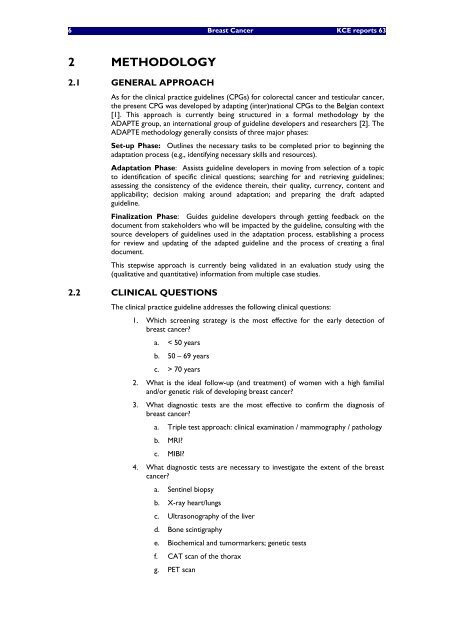Report in English with a Dutch summary (KCE reports 63A)
Report in English with a Dutch summary (KCE reports 63A)
Report in English with a Dutch summary (KCE reports 63A)
You also want an ePaper? Increase the reach of your titles
YUMPU automatically turns print PDFs into web optimized ePapers that Google loves.
6 Breast Cancer <strong>KCE</strong> <strong>reports</strong> 63<br />
2 METHODOLOGY<br />
2.1 GENERAL APPROACH<br />
As for the cl<strong>in</strong>ical practice guidel<strong>in</strong>es (CPGs) for colorectal cancer and testicular cancer,<br />
the present CPG was developed by adapt<strong>in</strong>g (<strong>in</strong>ter)national CPGs to the Belgian context<br />
[1]. This approach is currently be<strong>in</strong>g structured <strong>in</strong> a formal methodology by the<br />
ADAPTE group, an <strong>in</strong>ternational group of guidel<strong>in</strong>e developers and researchers [2]. The<br />
ADAPTE methodology generally consists of three major phases:<br />
Set-up Phase: Outl<strong>in</strong>es the necessary tasks to be completed prior to beg<strong>in</strong>n<strong>in</strong>g the<br />
adaptation process (e.g., identify<strong>in</strong>g necessary skills and resources).<br />
Adaptation Phase: Assists guidel<strong>in</strong>e developers <strong>in</strong> mov<strong>in</strong>g from selection of a topic<br />
to identification of specific cl<strong>in</strong>ical questions; search<strong>in</strong>g for and retriev<strong>in</strong>g guidel<strong>in</strong>es;<br />
assess<strong>in</strong>g the consistency of the evidence there<strong>in</strong>, their quality, currency, content and<br />
applicability; decision mak<strong>in</strong>g around adaptation; and prepar<strong>in</strong>g the draft adapted<br />
guidel<strong>in</strong>e.<br />
F<strong>in</strong>alization Phase: Guides guidel<strong>in</strong>e developers through gett<strong>in</strong>g feedback on the<br />
document from stakeholders who will be impacted by the guidel<strong>in</strong>e, consult<strong>in</strong>g <strong>with</strong> the<br />
source developers of guidel<strong>in</strong>es used <strong>in</strong> the adaptation process, establish<strong>in</strong>g a process<br />
for review and updat<strong>in</strong>g of the adapted guidel<strong>in</strong>e and the process of creat<strong>in</strong>g a f<strong>in</strong>al<br />
document.<br />
This stepwise approach is currently be<strong>in</strong>g validated <strong>in</strong> an evaluation study us<strong>in</strong>g the<br />
(qualitative and quantitative) <strong>in</strong>formation from multiple case studies.<br />
2.2 CLINICAL QUESTIONS<br />
The cl<strong>in</strong>ical practice guidel<strong>in</strong>e addresses the follow<strong>in</strong>g cl<strong>in</strong>ical questions:<br />
1. Which screen<strong>in</strong>g strategy is the most effective for the early detection of<br />
breast cancer?<br />
a. < 50 years<br />
b. 50 – 69 years<br />
c. > 70 years<br />
2. What is the ideal follow-up (and treatment) of women <strong>with</strong> a high familial<br />
and/or genetic risk of develop<strong>in</strong>g breast cancer?<br />
3. What diagnostic tests are the most effective to confirm the diagnosis of<br />
breast cancer?<br />
a. Triple test approach: cl<strong>in</strong>ical exam<strong>in</strong>ation / mammography / pathology<br />
b. MRI?<br />
c. MIBI?<br />
4. What diagnostic tests are necessary to <strong>in</strong>vestigate the extent of the breast<br />
cancer?<br />
a. Sent<strong>in</strong>el biopsy<br />
b. X-ray heart/lungs<br />
c. Ultrasonography of the liver<br />
d. Bone sc<strong>in</strong>tigraphy<br />
e. Biochemical and tumormarkers; genetic tests<br />
f. CAT scan of the thorax<br />
g. PET scan
















